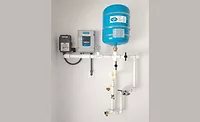Planning Can Save Time, Money for Drilling Jobs

Whether you’re drilling oil and gas or water wells, job planning can save a lot of grief, wasted time and money.
One of the most important, yet overlooked, aspects of drilling any kind of well is the five P’s step: prior planning prevents poor performance. This goes for the simplest house wells to the most complicated oil and gas wells. It is just as important, just a matter of scale. Poor engineering and planning on a deep well can easily cost a good percentage of the total cost of the job. This can be just as bad for a small driller; even though the costs are less, the percentage can be significant.
Before moving a rig onto a job, a few things need to be considered. Is the site accessible? At some times of the year, conditions can be so bad that matting or dozers will be needed to mobilize. Is that in the bid? Some states have serious weight restrictions during the spring thaw, making most rigs overweight. I know some drillers that have to unload all their drill pipe in the spring and haul it separately. And they can still be overweight. That is another trip that should be considered. On big, multi-load rigs, this means that loads need to be broken down and more trucks used, adding to the mob cost and time. Some loads, like big mud pumps, can’t be broken down, thus requiring permits. I’ve seen drillers try to slip a heavy load in when the DOT isn’t looking. This works ‘til he gets caught; then the fine is usually much more than the permit, and DOT will be watching him forever. Not worth it.
Next are supplies. If it is a new area, your bit company can usually give you an idea of drilling conditions, and bit selection for a couple offset wells from where you intend to drill. If it is a previously undrilled area, you ought to plan and charge for a lot of contingencies. I’m pretty sure Murphy’s Law was perfected on a wildcat location. On a small house well in your home area, you should be able to take everything with you. I’ve seen guys move the rig to the job just to keep another driller from getting it, then make several trips to town to get fuel, casing, mud and other things they should have had with them. This just cuts into the bottom line and wastes time.
On bigger jobs, a little more planning is necessary. Regular fuel delivery is one. If you are not in your home area, you may have to set up an account and schedule for delivery. Multiple casing strings need to be delivered at the appropriate time and that requires planning. Some non-API casing, which many water well drillers use, may be a special order, which takes time. Casing may end up with the same weight restrictions as the rig move, and permits may be required.
Mud is next. What conditions do you expect? Abnormal pressure or lost circulation? High formation pressure is fairly rare in the water well business, but lost circulation is common. Do you have the products on hand to treat for it? If not, does your supply house have it on hand? Sometimes, a heads-up to your supply house can save considerable down time waiting for a product you need.
If you are working out of town, have you considered crew driving time, or if you are a long ways from home, crew accommodations? Don’t forget, the crew gets paid for driving time, whether they are on the rig or not, but the hours are not generally chargeable to the customer. Both cost money and should be in the bid. Crew safety is more important now than ever. Have you located the nearest emergency services? Somebody’s life could depend on it.
On bigger wells, service companies will be involved. The customer may make a deal for logging and cementing, but as a driller you may need things like a contract welder to make repairs or a trash hauler or other services not the responsibility of the customer. Touching base with them is a good idea to see what kind of lead time they need to get to the rig, because the company men sometimes think that they can just pick up the phone and services will magically appear! In isolated areas, this may not be so. I’ve had to wait three days for a service company to come from Louisiana to North Dakota because nobody realized they didn’t have anyone near us. When they got there, they were not rigged up for winter conditions, and it took another day to get everything thawed out and running. Got to sleep in the truck a lot on that one.
These are the kind of things we think of when planning and bidding a well. Of course, the well engineering and design come first. The entire goal of the exercise is to make a useable well for the customer. Proper planning and engineering can make a profitable well. Poor planning can eat all your profits and add a significant amount of time to the job. If you are drilling for a fixed price, this not only costs you money when it happens; it also prevents you from moving to the next job. This costs double. If you are drilling on a day-rate or hourly, poor planning can sour the relationship with your customer and may cost future work. There is always a guy down the road that claims he can do it faster.
Plan your work, then work your plan.
For more Wayne Nash columns, visit www.thedriller.com/wayne.
Looking for a reprint of this article?
From high-res PDFs to custom plaques, order your copy today!



